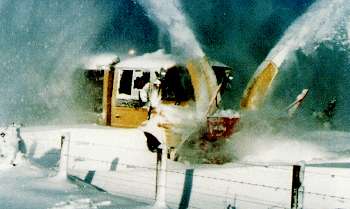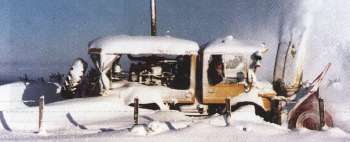

Case study material:
Accurate and timely weather forecasts are extremely important for business and the economy in general. Taking precautions against poor weather conditions is expensive - very expensive! Managing goods efficiently can mean high sales and good profits whilst poor management will see the wrong goods on sale and poor results. Weather conditions can make, or mar a holiday. Good weather encourages visits to the beach and sales of ice-cream, beach goods and everything associated with a good day out. Rain and poor sunshine can wreck an entire resort for months on end! The 'wrong type of snow' and 'leaves on the line' are well known excuses for late running trains - but accurate weather forecasting and action can ensure that the right equipment is in place and working to keep the trains running.
Good weather forecasting can help to ensure that both business and leisure activities can benefit from being in the right place at the right time. We may all be well used to watching TV weather forecasts before planning a day out, but.........
In these examples, weather forecasting provides warnings and time for planning. Accurate forecasting saves money, saves lives and makes an effective contribution to our way of life.

| 
|
| A snow blower in action | |
Maintaining safe and usable roads is a vital economic necessity. Vast quantities of materials are transported by road and large numbers of people use road transport to get to and from work, school and other places. All rely on road services (trucks, buses etc.) being able to get through in all weathers.
Local authorities have a responsibility to ensure that their roads are kept open. To ensure that they can do this effectively and efficiently they take very careful note of weather forecast conditions - and use the forecasts to plan salting and gritting (or in worst cases, snow ploughing and blowing) of the road surface. Grit provides hard chippings which are ground into the ice to break up the sheets and encourage melting - salt dissolved in the water and depresses the freezing point (temperatures must fall further before salt water freezes).
The Highland Council has responsibility for roads in the far north of Scotland - and allocates a budget of £5.5 Million each year for road clearance work.

| Main road routes in the Highland region Blue lines: Trunk routes - full maintenance cover including night patrols Red lines: Priority 1 - main routes with maintenance cover from 06:00 to 21:00 |
The Highland Council monitors road and weather conditions from the end of October to the middle of April in order to provide a winter maintenance programme for the treatment of snow and ice conditions.
Highland Council maintains stocks of over 100,000 tonnes of salt held in strategically placed sites throughout the Highlands. 550 men and 270 gritting and snowploughing lorries are on standby together with a fleet of snowblowers to deal with severe snow conditions. It is not possible to treat all roads at once (distances are high!) so a sytems of priority routes has been established. First priority is given to trunk roads, main roads (A roads) and other main routes. Second priority will be given to main service bus routes and third priority to main urban streets and school bus routes.
The Council maintains its own network of sophisticated automatic weather stations. Sensors at the side of the road measure air temperature, road surface temperatures and the state of the road - dry, wet or icy. With this information, and an accurate weather forecast, central controllers can make decisions about the need for salting and gritting and the roads to be treated.


Hampshire County Council has responsibility for road maintenance at the opposite end of mainland Britain - in the far south of England. Here conditions are not likely to be as harsh as in the Scottish Highlands, but the Council must be prepared to take action to ensure that winter roads are capable of supporting the intense traffic flows each and every day. Hampshire allocated £1.4 Million to road salting, gritting etc. in 1997/98. Responsibility for the main motorways (M3, M27) and trunk roads now rests with the government's Highways Agency - leaving Hampshire to deal with many thousands of miles of other roads.
In one area of eastern Hampshire, a team of 12 gritting and salting lorries cover some 500 of the 1500 miles of public road. Each lorry will spread about 5 tonnes of salt/grit in a night - about 1 tonne for every 10 miles of road. During one night's spreading, some 60 tonnes of salt is poured onto the roads of eastern Hampshire at a cost of some £3,000. Decisions about when and where to spread salt and grit depend on the availability of accurate and timely weather forecasts. If the forecast is correct, then £3,000 is well spent on keeping the main routes free from ice. If the forecast proves to be wrong, and the temperature does not drop below freezing point, then £3,000 is wasted and a large quantity of salt is dissolved into water on the road and sprayed onto the nearby vegetation by the passing traffic.
Snow is a major problem and one that is rather less usual than in Scotland! In Hampshire, major snowfalls may be expected only once in every 4 years - but the cost of the full snowplough, salt, gritting and snowblowing on the county's roads and motorways will be in excess of £250,000 per night. Because snow seldom falls in large quantities, much of the snow treatment equipment remains idle and is likely to suffer far more from rusting than from wear in use!
Maintaining major roads in a passable and safe condition throughout the winter months IS an expensive business. Local authorities pay very careful notice to the weather forecast and use these to help them to arrive at decisions about when, where and if to salt and grit the roads in their areas. Decisions are now aided by road-side monitors giving up to the minute information about local conditions. Hampshire County Council have recently commissioned a full thermal survey of all their roads - to determine those which are average, above average and below average temperatures - in order to ensure a tighter targetting of road maintenance. Road maintenance in winter is an expensive business.
|
A well-known High Street supermarket chain keeps careful watch on temperature and weather trends. Most supermarkets are re-stocked overnight
and continuously during the day using a method known as 'Just in Time' (JIT). Only low stocks are held at each store with replacements for
sold items being trucked in from a regional distribution depot (often sited near motorway junctions). Continuous monitoring of sales at
each checkout reveal the pattern of daily and hourly sales and help to define the loading of the trucks. Experience of sales patterns has
shown the supermarkets that sales of green salad vegetables and associated items go up when temperatures rise. When temperatures fall,
salad sales fall but the sale of ladies tights goes up!
A careful watch of weather forecast predictions for temperature can help to programme the goods loading for delivery to the stores. If temperatures are predicted to rise, then lower quantities of tights can be loaded, providing space for additional supplies of green salad vegetables. When the goods reach the store, the store should be able to meet the anticipated demand and show good stocks in the areas that sell well. Whilst the shelf space may remain the same, the store will have a greater stock as a result of the higher levels of trucked in supplies and will be able to meet demand. Check your local supermarket to see how displays change according to the seasons - and not just the large displays of Christmas crackers and Easter eggs! |
Agricultural uses
|
EUMETSAT, the operators of Meteosat, claim that the (high) cost of building, launching and operating sophisticated
weather satellites has been more than offset by the gains in agricultural productivity as a result of the improved weather forecasting
capability that the satellites provided.
At harvest times, it is essential that farmers plan their harvesting to occur after (at least) two days of sunshine to dry their crops. During the last weeks of the growing cycle, careful eyes will be cast towards the weather forecasts to try to plan a drying period followed by enough time to harvest the crop. Funded through EUMETSAT, a European partnership, the prime function of Meteosat is to improve weather forecasting accuracy across Europe. But, from its orbital position Meteosat is ideally placed to observe and record the pattern of weather across Africa and has helped to predict the pattern of drought and the expansion of the Sahara desert. Meteosat observations and forecasts are making a substantial impact on the growth of crops in these difficult areas. |
Forecasting for major sporting events
| Sporting events are big business - with big money prizes and widespread media coverage. Interruptions can be costly! Major events such as the Wimbledon Tennis championships are likely to retain specialist weather forecasting services to provide up to the minute local forecasting of rain. Using weather radar, the Met. Office can provide warnings of rain on the Centre Court with accuracies to within minutes - maximising the time for play and minimising interruptions for the televised matches. |
Ocean routeing
| The Met. Office maintain a specialist unit at their Bracknell, Berkshire, headquarters to advise shipping companies of heavy weather at sea. Companies can then advise their captains to steer routes that will avoid the worst weather conditions allowing cargoes and passengers to arrive at their destinations quickly (without having to slow down in rough seas) and in safety. |